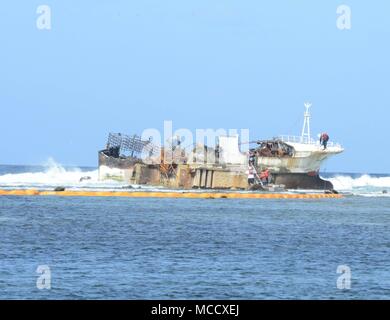
The Martech response included 50 personnel on site, the remotely operated vehicle TREC, and the submersible Pioneer I. PEMEX hired blowout control experts and other spill control experts including Red Adair, Martech International of Houston, and the Mexican diving company, Daivaz. The burning platform collapsed into the wellhead area hindering any immediate attempts to control the blowout. The oil and gas blowing out of the well ignited, causing the platform to catch fire. A loss of drilling mud circulation caused the blowout to occur. The IXTOC I was being drilled by the SEDCO 135, a semi-submersible platform on lease to Petroleos Mexicanos (PEMEX). The water depth at the wellhead site is about 50 m (164 feet). Initial Notification: On June 3, 1979, the 2 mile deep exploratory well, IXTOC I, blew out in the Bahia de Campeche, 600 miles south of Texas in the Gulf of Mexico. IXTOC I Bahia de Campeche, Mexico 1979-Jun-03 On-Water Recovery: Unknown/Not Applicable Shoreline Cleanup: Unknown/Not Applicable Dispersants: Applied In-Situ Burn: Applied Bioremediation: Unknown/Not Applicable Primary Threat: Oil Tags: Collision Products Of Concern: IXTOC I Crude Oil Latitude (Approximate): 19° 24.50′ North Longitude (Approximate): 92° 19.50′ West

#Myrtle irene dredge sinks manual#
Keyword: Inipol, Customblen, skimmer, sorbent belt skimmer, rope mops, sorbents, boom, pompoms, Corexit 7664, Corexit 9580, Corexit 9527, BP 1100X, International Bird Rescue and Research Center (IBRRC), Regional Response Team, fingerprinting, lightering, manual removal, vacuum truck, disposal, high-pressure hot water washing, high-pressure washing, low pressure washing, water-washing, remote response, side looking airborne radar (SLAR), steam generators, volunteers. Fate and effects monitoring by state and Federal agencies are ongoing. The response effort continued in 19 with cleanup in the summer months, and limited shoreline monitoring in the winter months. Shoreline cleanup began in April of 1989 and continued until September of 1989 for the first year of the response.

At the height of the response, more than 11,000 personnel, 1,400 vessels and 85 aircraft were involved in the cleanup. Logistical problems in providing fuel, meals, berthing, response equipment, waste management and other resources were one of the largest challenges to response management. The response to the Exxon Valdez involved more personnel and equipment over a longer period of time than did any other spill in U.S. The oil would eventually impact over 1,100 miles of non-continuous coastline in Alaska, making the Exxon Valdez the largest oil spill to date in U.S. Eight of the eleven tanks on board were damaged. Within six hours of the grounding, the Exxon Valdez spilled approximately 10.9 million gallons of its 53 million gallon cargo of Prudhoe Bay Crude. The vessel was traveling outside normal shipping lanes in an attempt to avoid ice. Initial Notification: On March 24, 1989, the tanker Exxon Valdez, en route from Valdez, Alaska to Los Angeles, California, ran aground on Bligh Reef in Prince William Sound, Alaska. T/V Exxon Valdez Bligh Reef, Prince William Sound, Alaska 1989-Mar-24 On-Water Recovery: Unknown/Not Applicable Shoreline Cleanup: Unknown/Not Applicable Dispersants: Applied In-Situ Burn: Applied Bioremediation: Applied

Tags: Collision Products Of Concern: Prudhoe Bay Crude Total Amount At Risk Of Spill: 10,900,000 Gallons Latitude (Approximate): 60° 50.33′ North Longitude (Approximate): 146° 52.98′ West
#Myrtle irene dredge sinks trial#
However, in the Clean Water Act Trial, Judge Barbier ruled in the FINDINGS OF FACT AND CONCLUSIONS OF LAW PHASE TWO TRIAL on January 15, 2015, that 4 million barrels of crude oil were released from the reservoir, of which 3.19 million barrels or approximately 168 million gallons were released into the Gulf of Mexico. (Related incidents: "Deepwater Horizon - Florida Commands") Editor's Note: Initial notification reports are not necessarily post-edited and updated. The Deepwater Horizon is located some 50 miles SE of the Mississippi Delta and contained an estimated 700,000 gallons of #2 Fuel Oil or Marine Diesel Fuel. Initial Notification: A fire and explosion occurred at approximately 11:00 PM CDT, Apon the Deepwater Horizon, a semisubmersible drilling platform, with more than 120 crew aboard. On-Water Recovery: Applied Shoreline Cleanup: Applied Dispersants: Applied In-Situ Burn: Applied Bioremediation: Appliedĭeepwater Horizon Gulf of Mexico 2010-Apr-21 Primary Threat: Oil Products Of Concern: Diesel, Crude Oil Total Amount At Risk Of Spill: 205000000 Gallons Latitude (Approximate): 28° 44.20′ North Longitude (Approximate): 88° 23.23′ West


 0 kommentar(er)
0 kommentar(er)
